The best of 2018: Our Top 10 stories worth reading again
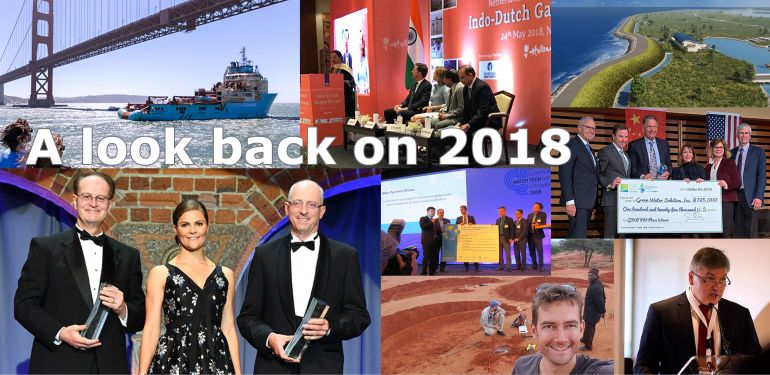 Only a few days left until the end of 2018. Looking back, it has been a very active year for the global water sector and the Dutch contributions have been accordingly.
Only a few days left until the end of 2018. Looking back, it has been a very active year for the global water sector and the Dutch contributions have been accordingly.
The editorial team of Dutchwatersector.com reported on these activities in over 300 news stories and we selected our top ten stories worth mentioning in this review.
What makes them worth rereading? For various reasons. Some because they reflect the creativity of the Dutch water sector, others because of the enormous contribution to help achieve the global frameworks, such as the Paris climate agreement, the Sendai agreement on disaster risk reduction or the Sustainable Development Goals, especially SDG 6 on water.
Below you will find our Top 10 stories of 2018 in chronological order.
If you like these news stories, please subscribe to our newsletter, follow us on Twitter and Facebook and of course, also keep reading and sharing the news stories on this website in 2019.
We wish you a happy and healthy New Year,
Editorial Team www.dutchwatersector.com
Support construction Singapore’s first polder – 3 April 2018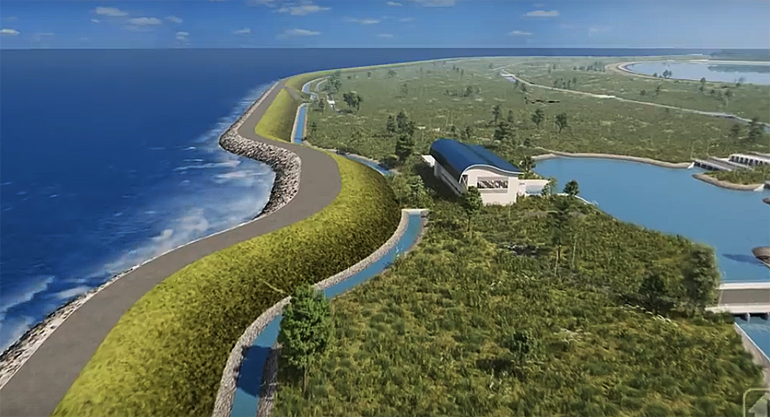 What is more typical for The Netherlands than a polder? Since the 12th century Dutch hydraulic engineers have constructed levees, drainage systems and pump stations to create new land. They’ve done so in many other countries, such as Japan, Korea, Germany and the United Kingdom. Now this tradition is being continued in Singapore, where Dutch firms are assisting the Singapore government to construct the first Singapore polder, extending the island of Pulau Tekon (see above impression).
What is more typical for The Netherlands than a polder? Since the 12th century Dutch hydraulic engineers have constructed levees, drainage systems and pump stations to create new land. They’ve done so in many other countries, such as Japan, Korea, Germany and the United Kingdom. Now this tradition is being continued in Singapore, where Dutch firms are assisting the Singapore government to construct the first Singapore polder, extending the island of Pulau Tekon (see above impression).
● Royal Boskalis to build 10 km levee around Singapore’s first polder
A turn-key, self-sufficient waste water plant, Port Said, Egypt – 2 May 2018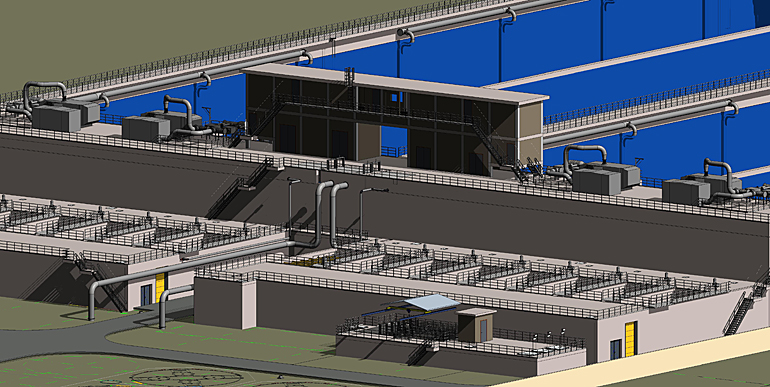 Water technology supplier Nijhuis Industries started the construction of a waste water treatment plant on the South Port Said Industrial Zone (SPIZ) in Port Said, Egypt. By July 2019 the plant is expected to treat 35,000 m3 waste water daily, and by 2020 it will have its full capacity of 60,000 m3 daily, making it one of the 10 biggest industrial waste water treatment plants in the world (see above impression). The anaerobic treatment system will produce enough biogas to feed the gas engines to produce power and make the plant energy neutral.
Water technology supplier Nijhuis Industries started the construction of a waste water treatment plant on the South Port Said Industrial Zone (SPIZ) in Port Said, Egypt. By July 2019 the plant is expected to treat 35,000 m3 waste water daily, and by 2020 it will have its full capacity of 60,000 m3 daily, making it one of the 10 biggest industrial waste water treatment plants in the world (see above impression). The anaerobic treatment system will produce enough biogas to feed the gas engines to produce power and make the plant energy neutral.
● Nijhuis Industries all geared up for industrial waste water treatment plant Port Said, Egypt
Support to Clean river Ganges goals – 25 May 2018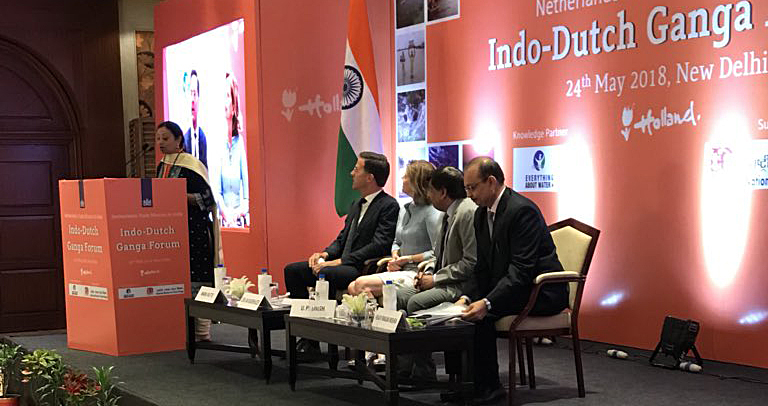
‘I have a great respect for the goals that have been set by Prime Minister Modi under the Namami Gange programme’, Dutch prime minister Mark Rutte said in May, speaking at the Indo-Dutch Ganga forum. The clean-up of the 2,500-km-long holy river Ganges is one of Modi’s flagship programmes with hundreds of projects ranging from reforestation, modernisation of ghats and crematoriums, and the construction of sewage collection systems and treatment plants. The Dutch and Indian water ministries signed a memorandum of understanding on a joined programme to prevent future pollution and to restore the river.
● Dutch prime minister Rutte supports Modi on goals for clean Ganges river
Regreening the African desert – 22 August 2018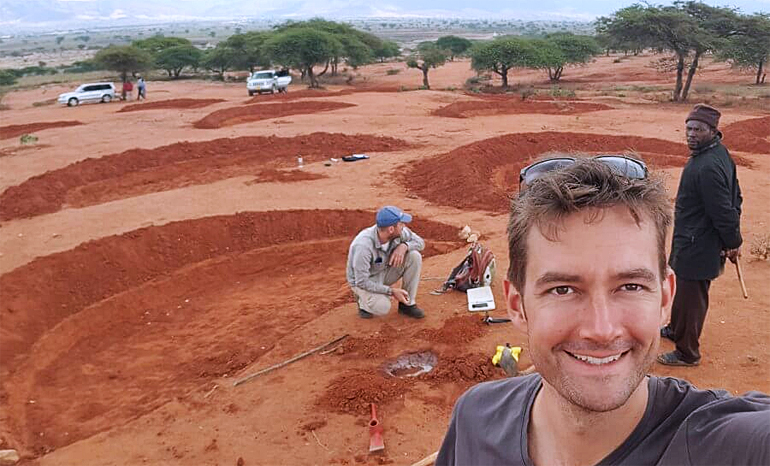
A hole in the ground, catches the rain and enables little amounts of vegetation to grow. Many holes (bunds), enables a lot of vegetation to grow and increases the local humidity in the air. Large areas with holes lead to more local rainfall and more vegetation growth and, eventually to the formation of local clouds. Corridors of these green areas can change the desert climate and slows down the process of erosion and desertification in Africa. The creation of such Green Corridors is the ultimate goal of the Dutch foundation JustDiggit. The foundation is now active in two African countries that face serious desertification. Here seen is the training of Tanzanian technicians how to dig soil bunds.
● JustDiggIt trains Tanzanian technicians to dig soil bunds to catch rainwater
Stockholm Water Prize for Mark van Loosdrecht – 30 August 2018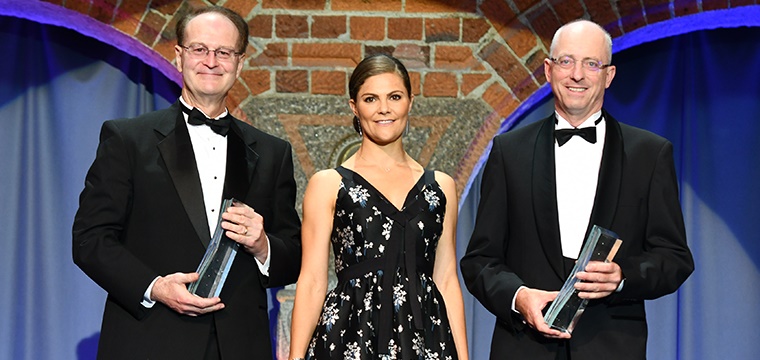
Dutch water technology professor Mark van Loosdrecht (right on photo above), together with his American colleague professor Bruce Ritmann (left), received this year’s Stockholm Water Prize for research on microbiological-based technologies to reduce significant costs of wastewater treatment and energy consumption, to remove harmful contaminants from water and to recover chemicals and nutrients for recycling. The presentation of the prize by Crown Princess Victoria of Sweden marked the importance of the ground-breaking work done by the two professors that led to a new generation of energy-efficient water treatment processes, such as Nereda and Anammox.
● Stockholm World Water Week 2018: Delft biotech pioneer Mark van Loosdrecht receives Stockholm Water Prize
Boyan Slat had a dream …. – 10 September 2018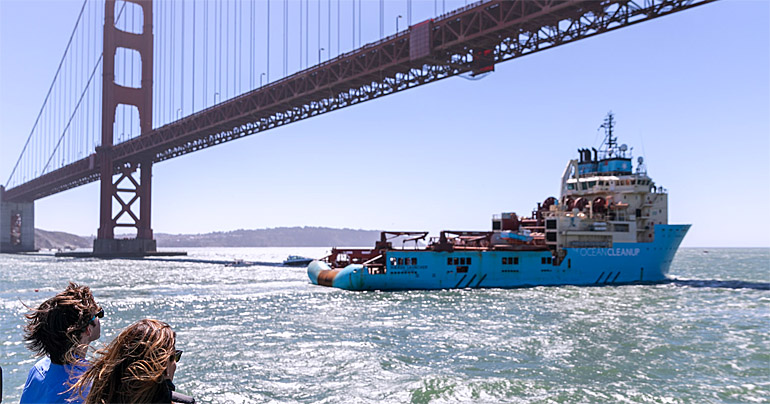
As a 17-year-old student at the Delft University of Technology, Boyan Slat went on diving vacation in Greece and came out of the water frustrated because he had seen more plastic than fish. It became his mission to clean up the plastic from the sea. He started a crowdfunding campaign that raised 20 million dollars for the development of a floating device to collect plastic waste from the oceans, starting with the biggest plastic soup in the world, what’s known as the Great Pacific Garbage Patch.
The development of the floating plastic collection system has not been easy, and at this moment Boyan Slat is still very busy improving the performance of the system. On 8 September the first prototype version was tugged out from San Francisco, making a dream come true for the now 24-year-old CEO of the Ocean Cleanup enterprise (left on photo above, while passing the Golden Gate bridge).
● The Ocean Cleanup: ‘Great Pacific Garbage Patch, here we come’
Connecting water tech hubs – 28 September 2018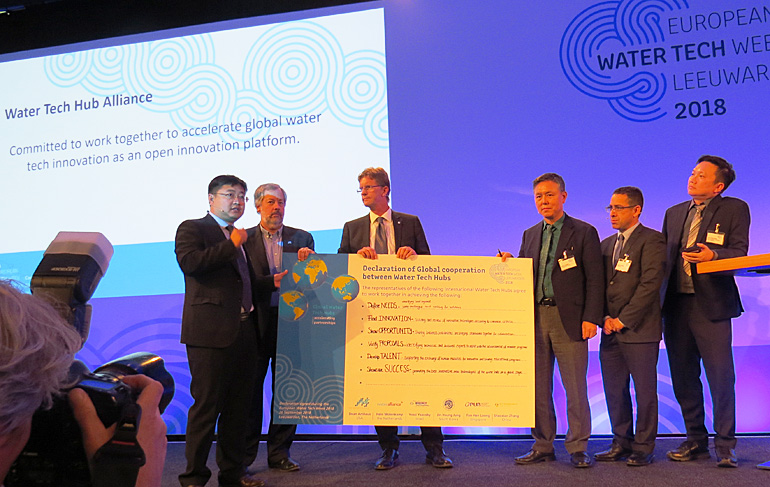
Six water tech hubs from China, South Korea, USA, the Netherlands, Israel and Singapore, gathered at the first European Water Technology Week in Leeuwarden, the Netherlands in September 2018. On the occasion they signed an agreement for a global cooperation to accelerate the market introduction of innovative water treatment technologies. Small businesses lead the innovation of water technologies, but they lack the scale to roll out their innovations worldwide and create a good return on investment. The agreement by the six hubs intends to break this vicious circle by creating ‘stepping stones’ to the regional water tech markets. The agreement (initiated by Hein Molenkamp of Water Alliance, middle on photo above) also includes the support of talented researchers and young professionals on a global scale.
● EWTW2018: Six water tech hubs agree on global cooperation to accelerate market introduction of innovative technologies
Combat toxic algae bloom – 26 October 2018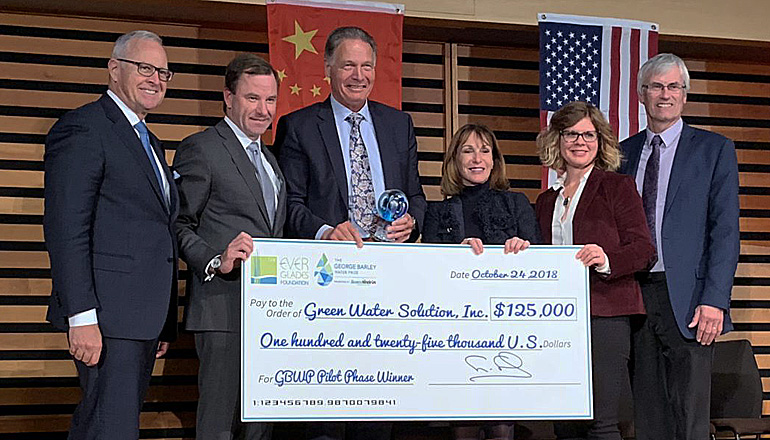
After more than two years of testing their technologies in laboratories and in the Lake Simcoe watershed, the four finalists in The George Barley Water Prize were announced at the Ontario water innovation week in October. Two of the four finalists have Dutch roots, being research institute Wetsus and water technology firm Green Water Solution (with CEO Koos Baas with prize on photo above). The George Barley Water Prize offers a 10-million dollar incentive award to find a new technology capable of removing phosphorus from surface water. Many lakes in the world are heavily polluted with toxic algae, impacting the intake by water supply utilities. Main cause for the algae bloom are high concentrations of phosphorus.
The Barley Water Prize challenges the finalists to come up with the best treatment technology to remove low-concentrated phosphorus cost-effectively.
● Wetsus and Green Water Solution amongst four finalists Barley prize to combat algae bloom
AIWW Summit: Drive climate adaptation and SGD 6 forward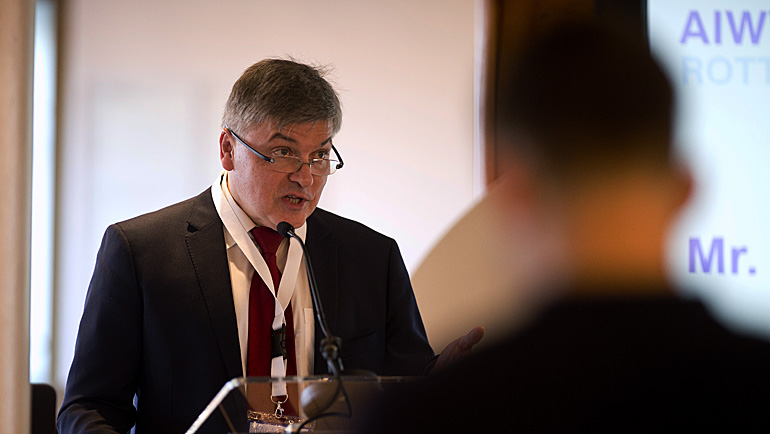
"The impact of climate change will not be alleviated by talking", said Poland’s special climate envoy Thomasz Chruszczow at the AIWW Summit 2018. Chruszczow addressed the delegates of the summit that was held to collect input for the next edition of the Amsterdam International Water Week to be held in November 2019. His call for action reflected the ambition of the organisers of the AIWW to make concrete steps forward by initiating showcases and taking global leadership in urban resiliency and circular economy. Overarching aim is to make real impact and accelerate climate adaptation and the implementation of the Sustainable Development Goals, and SDG 6 on water in particular.
Reflecting this ambition, the summit saw the signing of two new ´Amsterdam Agreements´. One by the water utilities of Amsterdam and Paris on a closer cooperation to develop new knowledge, and a second one by FMO Dutch development bank and the Netherlands Water Partnership (NWP) on the financing of more water projects. At the next AIWW in November feedback will be provided on the progress of these Amsterdam Agreements, including the nine agreements that were already signed at the previous edition of the AIWW.
● AIWW Summit 2018: How to speed up climate adaptation globally?, 20 November 2018
True value of water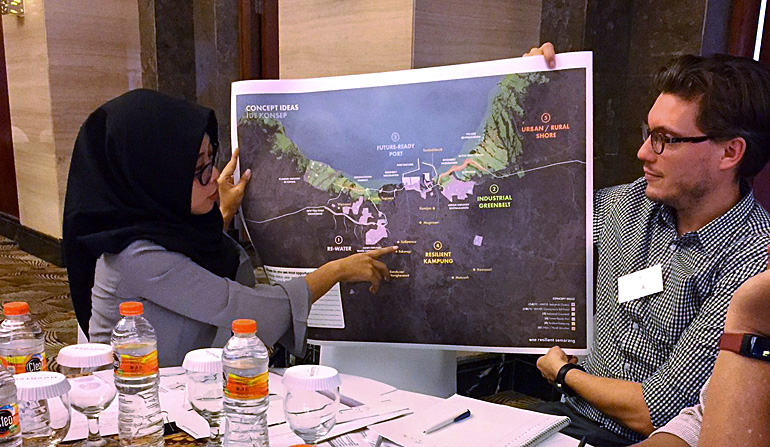
In three Asian cities, Chennai (India), Semarang (Indonesia) and Khulna (Bangladesh) workshops have been held to develop plans that not only address the water problems in these cities, but also improve the livelihood of its inhabitants or contribute to the economic development of the city. Water as leverage; that is the name of the programme, launched by the Dutch government and supported by the United Nations, the World Bank and the Asian Infrastructure investment bank.
In December the first phase of the programme was concluded with a presentation of six designs, two for each city, to change water, urban and climate problems into opportunities, such as storage of storm water for periods of water shortage, new waterfronts that include harbours.
Representatives of financial institutions reacted enthusiastic to the presented designs, providing confidence for the next phase of the programme when the six designs will be transferred into bankable projects. The programme aims to realise transformative projects in all three Asian cities, involving a very broad coalition, with communities, businesses, municipalities, none-governmental organisations and city designers.
● Water as leverage: City designs gather momentum with presentations to financial sector, 24 December 2018
Read also on this website
● The best of 2017: Top 10 news stories on the Dutch water sector, 29 December 2017
● The best of 2016: Our top 10 news stories on the Dutch water sector, 28 December 2016
● Our top 10 news stories of 2015, 5 January 2016
More information
Netherlands Water Partnership
The Hague, the Netherlands
+31 70 304 37 00
info@dutchwatersector.com
www.netherlandswaterpartnership.com



